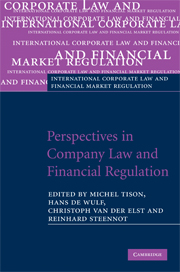Book contents
- Frontmatter
- Contents
- List of contributors
- Foreword
- PART I Perspectives in company law, SECTION 1: European company law: regulatory competition and free movement of companies
- PART 1 Perspectives in company law, SECTION 2: Corporate governance, shareholders' rights and auditing
- PART 1 Perspectives in company law, SECTION 3: Takeover law
- PART II Perspectives in financial regulation, SECTION 1: European perspectives
- 24 Principles-based, risk-based regulation and effective enforcement
- 25 The Committee of European Securities Regulators and level 3 of the Lamfalussy Process
- 26 Market transparency and best execution: bond trading under MiFID
- 27 The statutory authority of the European Central Bank and euro-area national central banks over TARGET2-Securities
- PART 2 Perspectives in financial regulation, SECTION 2: Transatlantic perspectives
- PART III Miscellaneous
- Index
- References
24 - Principles-based, risk-based regulation and effective enforcement
from PART II - Perspectives in financial regulation, SECTION 1: European perspectives
Published online by Cambridge University Press: 04 August 2010
- Frontmatter
- Contents
- List of contributors
- Foreword
- PART I Perspectives in company law, SECTION 1: European company law: regulatory competition and free movement of companies
- PART 1 Perspectives in company law, SECTION 2: Corporate governance, shareholders' rights and auditing
- PART 1 Perspectives in company law, SECTION 3: Takeover law
- PART II Perspectives in financial regulation, SECTION 1: European perspectives
- 24 Principles-based, risk-based regulation and effective enforcement
- 25 The Committee of European Securities Regulators and level 3 of the Lamfalussy Process
- 26 Market transparency and best execution: bond trading under MiFID
- 27 The statutory authority of the European Central Bank and euro-area national central banks over TARGET2-Securities
- PART 2 Perspectives in financial regulation, SECTION 2: Transatlantic perspectives
- PART III Miscellaneous
- Index
- References
Summary
Enforcement intensity may impinge on capital market competitiveness. It also has implications for the development of international securities regulation, which is increasingly likely to depend on determinations of equivalence as between different national (or regional) regimes.
The UK Financial Services Authority is not enforcement-led and, in tune with its principles-based, risk-based approach, it employs a range of compliance-promoting strategies. Its measured approach to enforcement divides opinion and particular controversy surrounds its application in relation to market abuse. This chapter reviews the Financial Services Authority's enforcement record in this difficult area and identifies challenges that lie ahead.
What does principles-based, risk-based regulation mean?
The essence of the distinction between rules and principles lies in their specificity. At opposite ends of the spectrum lie: a ‘rule’ which is written in such detailed and precise terms that all questions about what conduct is permissible are settled in advance leaving only factual issues for later judgment; and a ‘principle’ (or ‘standard’) written in open-textured language that leaves open both specification of what conduct is permissible and judgment on factual issues. Many, if not most, regulatory requirements will occupy the space between these endpoints showing more (or less) of the characteristics of a rule (or principle), being as Cunningham has put it, ‘hybrids along a continuum’. The combination of principles, rules and all points in between within a legal system can, in jurisprudential terms, be seen as a compromise between two social needs: ‘the need for certain rules which can, over great areas of conduct, safely be applied by private individuals to themselves without fresh official guidance or weighing up of social issues, and the need to leave open, for later settlement by an informed, official choice, issues which can only be properly appreciated and settled when they arise in a concrete case’.
- Type
- Chapter
- Information
- Perspectives in Company Law and Financial Regulation , pp. 427 - 448Publisher: Cambridge University PressPrint publication year: 2009
References
- 2
- Cited by

